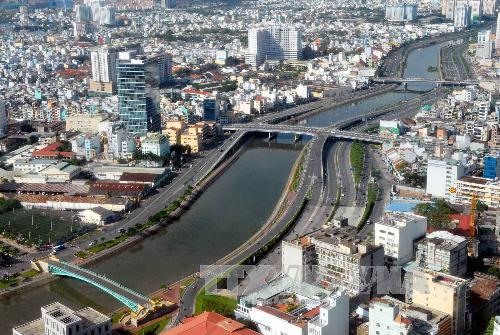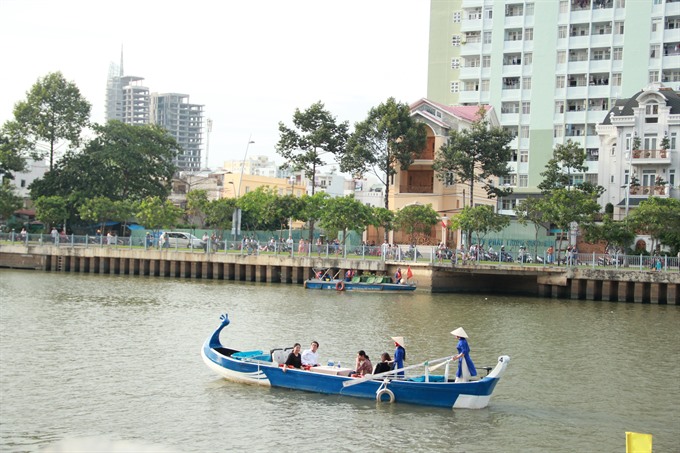 Features
Features

With nearly 1,000 kilometres of rivers and canals, the potential for developing waterway tourism in the HCM City metropolitan area is enormous, but this is limited by the lack of a serious effort to avoid pitfalls like increasing pollution.
 |
| The Tàu Hủ-Bến Nghé Canal in HCM City. Photo Mạnh Linh |
With nearly 1,000 kilometres of rivers and canals, the potential for developing waterway tourism in the HCM City metropolitan area is enormous, but this is limited by the lack of a serious effort to avoid pitfalls like increasing pollution. Thu Hằng reports.
HCM CITY — The HCM City metropolitan area, which lies downstream of the Đồng Nai-Sài Gòn rivers system, is surrounded and traversed by nearly 1,000 kilometres of rivers and canals, which offer enormous potential for waterway tourism.
In recognition of this potential, the city in 2013 began a programme for waterway activities, but a lack of investment in infrastructure and increased pollution have led to disappointing results.
In all, from 2013 to the third quarter of this year, the number of tourists buying river tours rose 11.5 per cent to 257,700. But in the first nine months of the year, the number remained unchanged at 68,000, the same as during the first nine months of 2015.
However, the city welcomed more than 3.6 million foreign visitors in the first nine months of the year, an increase of 13 per cent compared to the same period last year, according to the city’s Tourism Department.
Phan Xuân Anh, a culture and tourism researcher, who is chair of the board for Saigon Boat Co, said that exploring the river and its waterways and canals surrounded by lush tropical foliage was a popular activity for foreign tourists.
The city’s main source of fresh water is the Đồng Nai River, which has a large basin of 45,000sq.km, while the 200-km long Sài Gòn River flows through the city’s area.
Apart from these main rivers, the city has a dense network of canals, including Bến Cát, Tham Lương, Nhiêu Lộc-Thị Nghè, Bến Nghé, Tân Hóa- Lò Gốm and Tàu Hũ.
Since 2013, the city has allocated funds for 13 berths and wharfs for tourist boats to dock, while 21 others have been funded by private investors.
In 2014, the number of river tourism operators rose to 37 firms, with more than 130 boats, compared to five firms with 37 waterway transporters in 2011.
Last year, however, the number of operators fell to 19 with around 100 boats, due to the closure of Bạch Đằng Wharf, a busy docking place for tourism boats and floating restaurants on the Sài Gòn River, according to Vũ.
 |
| A boat tour along the Nhiêu Lộc-Thị Nghè Canal, with an investment of VNĐ16 billion (US$708,000)gets positive feedback from foreign tourists. Photo Thu Hằng |
Challenges
In late 2012, the Saigontourist Holding Company was assigned by the city government to explore river tourism, Phạm Huy Bình of Saigontourist said.
By mid-2013, the company had launched seven river tours to lure domestic and foreign tourists but the results fell short of expectations.
The river tours departed from Bạch Đằng Wharf in the city’s centre to tourist attractions such as Long Phước Garden in District 9, Phú Mỹ Hưng in District 7, Bình Quới Village in Bình Thạnh District, Củ Chi Tunnel and Cần Giờ Forest.
Bình said the services were unattractive for a number of reasons, including poorly developed docking berths and tourist services along the banks of rivers and boat stations, as well as high tour fares and pollution.
To attract visitors, Saigontourist invested in a new 800-seat boat, which includes a restaurant.
However, after the Bạch Đằng Wharf closed, tourist boats had to dock at Tân Cảng Port in Bình Thạnh District, far from the city centre, making it more difficult to lure visitors for river tours, Bình said.
He said a city master plan on river tourism should be developed so that businesses can create their own plans.
Phan Xuân Anh, board chairman of Saigon Boat Co Ltd, said rowboat tours along the Nhiêu Lộc-Thị Nghè Canal, with an investment of VNĐ16 billion (US$708,000), had to be suspended because of pollution and massive fish deaths.
The canal is still polluted with waste discharged by local residents, Anh said.
The boat tour, which was launched last year, received positive feedback from foreign tourists, but waste must be removed from the canals, he said.
Dương Thanh Thủy, chairwoman of the Trung Thủy Group, invested in a new river tourism product called “Saigon Corner”.
The project on the Tàu Hủ-Bến Nghé Canal in District 1, with an investment of VNĐ100 billion (US$4.42 million), will have different sections from the Mống Bridge to Khánh Hội Bridge, including a community space in old Sài Gòn, as well as corners for street food and coffee. If approved, construction will begin soon, with an expected opening by 2018.
River tourism plan
Nguyễn Thành Phong, chairman of the city’s People’s Committee, said the development of river tourism would play a vital role in the tourism industry, a spearhead economic sector for the city.
He said that solutions were being proposed to revamp the waterway programme and asked the tourism department to quickly finalise the river tourism development plan.
He has also asked local authorities to survey on the banks of the Sài Gòn River to find places for tourist boat berthing.
“River tourism will help diversify tourism products and attract more tourists, as well as boost spending on tourist services and products,” he added.
Bùi Xuân Cường, director of the city’s Department of Transport, said the department had proposed setting aside an area of 1,800 metres at Nhà Rồng-Khánh Hội Port for tourist boats.
He said that Bình Lợi Bridge had been upgraded to allow tourist boats to enter the city’s centre.
“Enterprises cannot make business plans to develop river tours as the city has failed to present a master plan and to provide concrete information on river tourism development,” Bùi Tá Hoàng Vũ, director of the city’s Tourism Department, said.
Next year, when the Department implements its tourism waterway plan, companies would be able to develop their own business plans, Vũ said. —VNS




